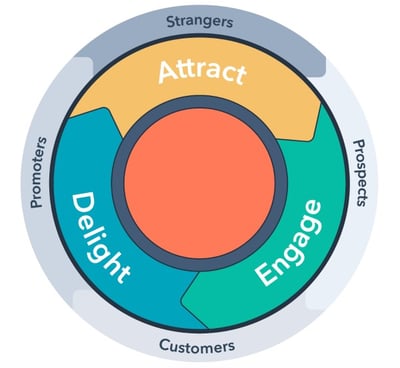How to Use B2B Customer Testimonials as a Marketing Force
Written by
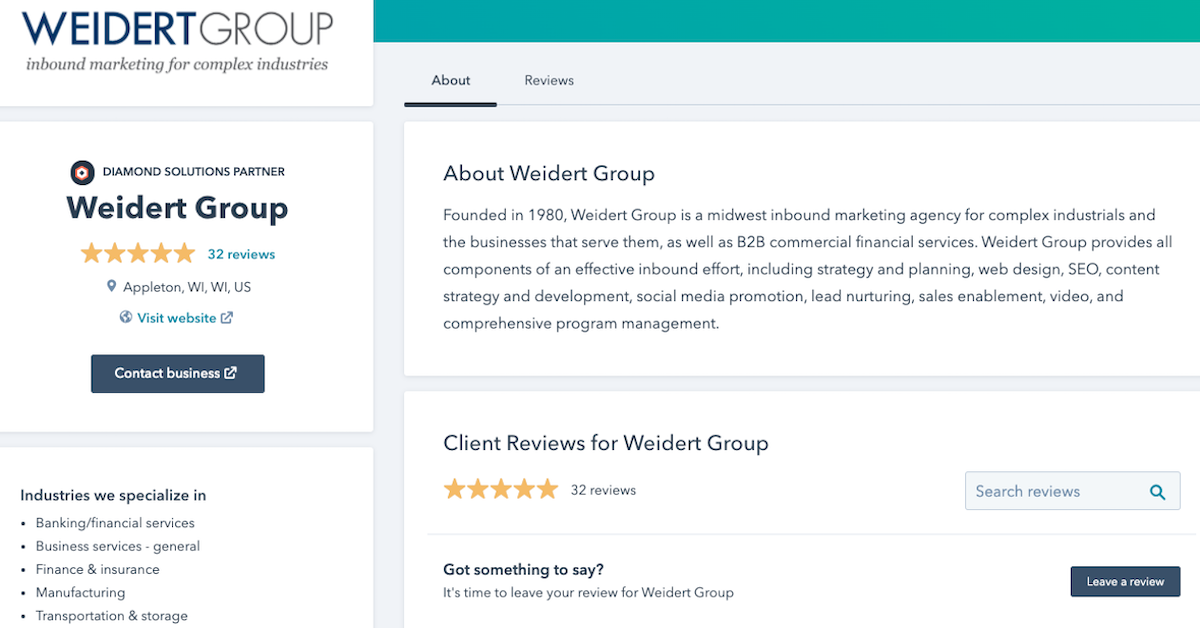
You know you make a great product. And you want to tell the entire world about it. But the world hearing that from your sales force isn’t as powerful as hearing it from one of your delighted customers or business partners.
In fact, 97% of B2B customers say that user-generated content, such as a peer review, is more credible than other types of content.1
People lean on reviews and testimonials before they make decisions. So, the better your customers feel about your product — and the better they can voice that in a testimonial — the more success your team will have.
In this article we’ll cover:
- Why use testimonials in B2B marketing
- How to get good customer testimonials by asking and automating
- How to use testimonials as marketing flywheel force — in your content, videos, website, and more
Why use testimonials in B2B marketing?
Testimonials are a vital fuel for generating force in the “customer delight” area of your inbound marketing flywheel. This often overlooked area has incredible potential to help grow a business. The main obstacle is usually determining the specific ways to collect testimonials.
Before we dig into using customer testimonials to their fullest (most powerfully by creating a Voice of the Customer program), let’s review the importance of gathering and using testimonials.
If you’re online shopping for a new outdoor fire pit, you’re likely expecting to read reviews from those who’ve purchased different ones. As a consumer, they’re enlightening, informative, and can skew your opinion.
However, you may not necessarily expect to read reviews of a new ISO 8-classified jet energy mill pulverizer. Yet, for a business needing specifically that piece of advanced machinery, a review or testimonial can be incredibly influential in the purchase decision.
Exactly how influential is “incredibly influential”? Well, it’s time for more eye-opening facts about the impact of testimonials on the buyer’s journey!
- 92% of B2B buyers are more likely to purchase after reading a trusted review.2
- Including a customer testimonial on a landing page can increase page sale conversions by up to 34%.3
- 88% of consumers trust online testimonials and reviews as much as recommendations from friends or family.4
Woah, did you catch that last one? An online testimonial is nearly as trusted as your BFF or sweet Aunt Petunia! We’ll explore why that is shortly. Just remember now that your current customers have the most influence in your prospects’ buyer’s journey.
If you’re doing a good job of solving their problems, and delighting them with your outstanding service, they’ll want to tell others about what you did for them. It’ll speak so much louder than saying it yourself.
How do you get good testimonials?
Although getting this feedback from your customers may seem like a time-consuming task, it’s a worthwhile pursuit: Using customer testimonials regularly can generate approximately 62% more revenue!5
So, how do you get them? There are two simple steps:
- Ask! OK, ask politely and make it clear how much you value feedback from your customers. You can ask within various customer connection points: on your website (pop-up or on the Contact Page), in follow-up emails, during phone calls, satisfaction surveys, etc.
You can also encourage customers to leave a Google review for your business (those information sidebars shown when someone conducts a search for you). You’ll be showcasing positive experiences from the very beginning, before a visitor even makes it to your website.
What about starting a referral program for your business? Examine your good testimonials, encourage them to spread their good experience, and reward their loyalty. They’re effective because they leverage happy customers’ recommendations, recognize customers’ brand loyalty, and are very popular with customers. - Utilize software to automate and scale the collection of customer feedback. The right technology makes this easy, scalable, and trackable. HubSpot, for example, has customer feedback tools available within their Service Hub offerings. This includes a variety of surveys to help you uncover what customers think about you, which can be set up to automatically send based on the customer’s behavior, such as a support ticket closed, a purchase completed, or a key deliverable date entered into the CRM. Great feedback can trigger automated asks for testimonials from those customers.
Read this article to learn more about creating a customer feedback plan.
What to look for in a testimonial?
So, what is a good, or bad, testimonial? In a previous blog post, we covered what you should look for in a customer testimonial. Simply put, a customer testimonial should:
- Be honest and authentic — Refrain from using misleading reviews as part of your content strategy.
- Be specific — Give brief, specific details that the reader will be able to relate to.
- Illustrate what makes your company unique — Share what makes your company and products different than the rest.
How do you use testimonials to generate marketing force?
Now that you truly understand the drastic effect that testimonials can have on your revenue, let’s dive into how you can use them to generate force in your inbound marketing flywheel.
You’ve identified and created testimonials from some of your best and most delighted customers. Now what? We’ve compiled a list of the best ways to use them in your content.
Website Pages
Websites using testimonials saw a 45% increase in traffic compared to those who didn’t,6 plus testimonials can increase conversions on sales pages by as much as 34%.7
The first page to consider is your Home Page. Not only can a testimonial be a helpful, persuasive tool, but providing a link to your Testimonials Page also acts as a quick and easy way for additional customers to leave a review. Other pages to think about: Product Pages, Sales Pages (see stat above), About Us Page, etc.
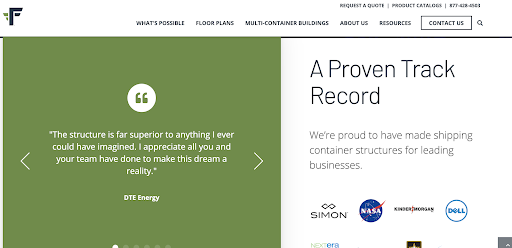
This testimonial appears on the Home Page of our client, Falcon Structures, after the visitor scrolls down the page. Notice how the short, powerful testimonial is positioned next to the area featuring customer logos, creating a subtle connection between them.
Plus, depending on the page being viewed, a pop-up with the right testimonial could yield good results.
Videos
42% of people say testimonial videos are effective because they showcase an actual person and help the viewer understand their story.8
Two out of three people say they’d be more likely to make a purchase after watching a testimonial video demonstrating how a business, product, or service had helped another person like them.8
RELATED: What is a Company Culture Video and Why You Need One
Videos communicate simple or complex information in a way that’s easy to digest. They also allow customers to see themselves in just about any story or situation. The only confusion may be where to place them for maximum effectiveness.
There are few “wrong” places to use video, actually. It just needs to complement the content around it. In addition to the website pages mentioned earlier, many B2B organizations regularly use social media as part of their inbound marketing strategies, which is perfect for video.
This video features a tissue converter raving about how a specific machine line manufactured by our client, Fabio Perini, provides a competitive advantage in the tissue industry.
Just a reminder, a testimonial video featuring employees discussing your company is also a great way to attract skilled workers in a shrinking labor pool.
RELATED: Why and How Manufacturers Should Use Videos in Recruiting
Blog Articles and Case Studies
What makes for a wonderful blog post or case study? A compelling story about how someone became a delighted customer. And if another prospect reads how someone similar purchased that piece of equipment and realized incredible growth and profits? Nothing could be more valuable!
Choose the testimonial below that packs more punch:
“This product is incredible! It made my life better, and it’s a tremendous value for the price!”
or
“My gut reaction to your product was that it costs too much. But once I started using it, I realized a streamlined process and much better organization. I can now focus my attention on the vital parts of my business and not worry about the small, day-to-day issues. The cost seems like a steal. Knowing what I know now, I’d happily have paid three times as much!”
Blog articles and case studies let you go into detail about the entire process. A testimonial gives your readers a chance to reflect on all the decisions that were made and how/why the customer selected your solution. Everyone loves a great story.
Just make sure you use blog articles with testimonials at the right points in the buyer’s journey, when prospects are looking at the big picture, wondering if your company is experienced and trustworthy.
Later in the buyer’s journey (bottom of the funnel), a testimonial about how a specific machine increased productivity by 23%, for instance, fits perfectly into a case study or email, giving a prospect the details they need before making a purchase decision.
Directory/Review Sites
Third-party review sites and industry-specific directory listings are highly influential. On their own, they’re important, but if your company has testimonials or actual reviews posted on your business’s profile page? That’s key to getting true value from these opportunities.
If you’re listed in an industrial directory, but you have no reviews or testimonials, your profile is weaker than those that have them. Not to brag, but here’s what people see when they search for Weidert Group in HubSpot's partner directory: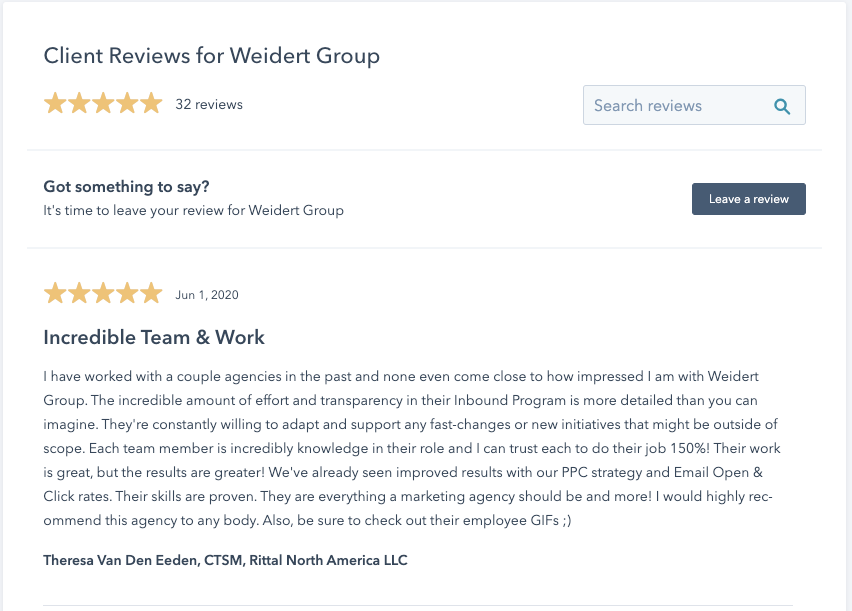
The most recent review is listed first, with another 31 reviews after. That adds up to quite a statement to anyone searching for a reliable inbound marketing agency.
Here’s the bottom line: Delight your customers, and that delight will come back to you (although you may need to ask for it.) Leverage positive feedback on your website, in videos, within blog posts and case studies, on social media, and more!
Once you get used to obtaining and using authentic customer testimonials, it becomes second-nature. You’ll see more traffic to your website, better qualified leads and, ultimately, a better bottom line.
Ready to also make content creation simpler and more effective? We’ve created a guide with templates and checklists to help you. Ironically enough, we named it The Ultimate Content Creation Guide, and you can get your copy by clicking the link below!
Although getting this feedback from your customers may seem like a time-consuming task, it’s a worthwhile pursuit: Using customer testimonials regularly can generate approximately 62% more revenue!5
Subscribe To Our Blog
Information. Insights. Ideas. Get notified every time a new Weidert Group blog article is published – subscribe now!
You May Also Like...
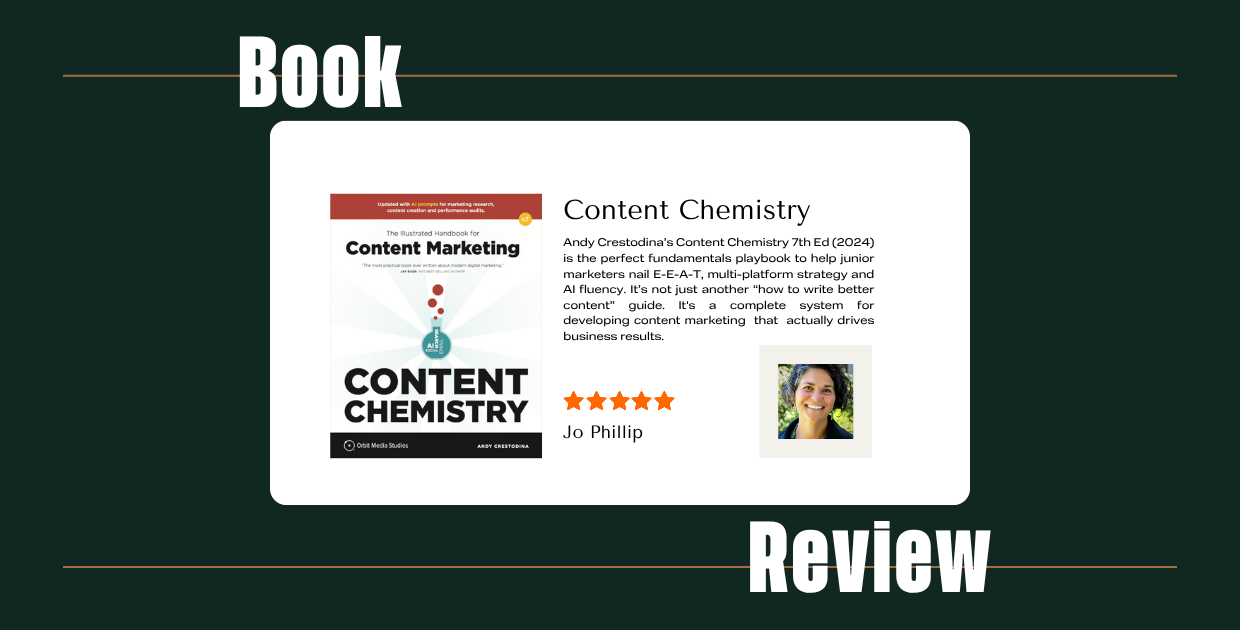
Content Marketing
AI-Era Marketing Simplified: Content Chemistry, 7th Edition

Marketing Case Studies
How ESOP Partners' Website Strategy Boosted SQLs by 900%

Marketing Technology
What is an AI Agent? Ready or Not, They're Reshaping How Industrials Market & Sell
Accelerate Your Growth with
Weidert Group
If you’re ready to explore a partnership, request a personalized consultation with our team.
